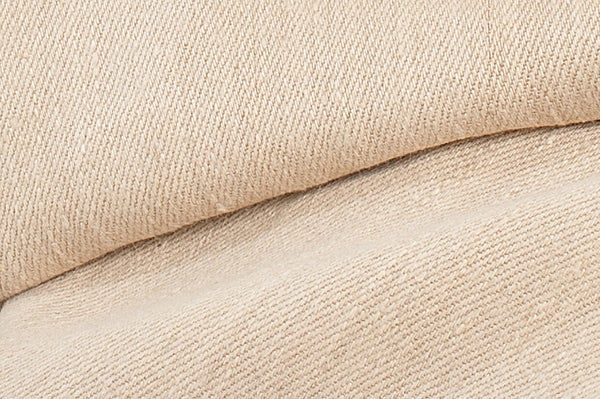Hemp textile
In addition to the environmentally friendly cultivation and production process, we will introduce you to the special properties of hemp fabric.
Hemp, an easy crop
Hemp is one of the fastest growing crops in the world; it grows twice as fast as cotton. After planting, it only takes 3 to 4 months for the plant to mature and be harvested. In some areas, the crop can therefore be harvested multiple times a year. The plant is also able to grow on a variety of soils, as its roots go very deep, allowing them to easily reach water. These properties make the plant easy to cultivate.
Sustainability
Besides the fact that the hemp plant is an easy crop to grow, this plant has even more advantages with regard to sustainability:
- The crop does not exhaust the soil nearly as much as other crops, and therefore requires little to no artificial fertilizer. Less use of artificial fertilizer is a big advantage, because it reduces pollution of the soil and waterways.
- The plant is not bothered by insects, so little to no pesticides are needed. This is good news, because Pesticides, when used in excess, are harmful to the environment.
- The plant itself prevents weeds from growing. For this reason, hemp crops do not need to be protected from weeds, which saves a large amount of herbicides.
- The crop needs little water to grow. Usually, an irrigation system is installed to water the plants, which is intensive work. This is usually not necessary for growing hemp.
- The plant can be used as a 'cleaning crop' to purify waste water. In Chernobyl, for example, hemp is grown to clean up nuclear pollution in the soil.
- Several studies show that hemp cultivation creates better conditions for biodiversity than most other monocultures.
GOTS certified
The hemp we use is supplied by a GOTS certified supplier that stands for environmentally friendly production, fair trade and best quality. The hemp is grown in various countries in Europe; France, Hungary, Romania, Moldova and Belarus. The material is then moved to Romania, where the processing takes place. Read more about this below.
The hemp production process
- The cultivation: Hemp production starts with the cultivation of Cannabis Sativa. The cannabis that is cultivated contains almost no psychoactive substances. The plants without these substances have a much higher fibre content.
- Retting: Retting involves exposing the mown hemp stalks to water. During this process, moisture releases the fibres from the plant. There are three ways to do this: dew retting, blue retting, and warm water retting. With dew retting (also known as field retting), the stalks are spread out over the ground from September to October. Dew and rain create the necessary moisture. With blue retting (also known as mud retting), the stalks are placed in a retting pit in standing water. Finally, there is warm water retting, where the stalks are placed in underground concrete containers in warm water.
- Debarking: immediately after retting, the woody core can be removed from the stems. This is done by hand or with the help of special machines.
- Additional processing: after debarking, the hemp fibres can actually be spun. Sometimes, however, various intermediate steps are added for an extra soft end result, such as washing in diluted acetic acid.
- Spinning: The final step is to machine spin the hemp. The fibres are then twisted together into threads. These threads are sometimes sealed with wax to make them water-repellent. To make extra soft textiles, organic cotton fibres are sometimes added to the hemp during this step.
Properties of hemp textiles
Hemp textiles have a number of pleasant properties: the material is moisture-absorbent and therefore well protected against stains. The fabric also keeps out more UV rays than other fabrics. Studies have shown that hemp prevents the growth of staphylococcus bacteria, which cause skin infections. For people with sensitive skin, this can be a great help.
Properties of hemp textile
In addition to these advantages, hemp textiles have a number of other beneficial properties:
- Textiles made from 100% hemp last approximately 3.3 times longer than cotton. Hemp fibres are ten times stronger than cotton fibres. This saves both money and the environment.
- The hemp fabric can be washed at 30 degrees and does not need to be ironed, which saves energy consumption.
- The material does not absorb stains as quickly, which means it needs to be washed less often. This also means that less aggressive detergents need to be used.
- The material becomes softer and more comfortable to wear as you wash it often.
- The fabric is lighter than many other fabrics, which means it dries quickly and does not need to be tumble dried.
- Hemp is naturally moth resistant.
Our hemp shrouds
Our Hemp shroud and Denim shroud are made of this special hemp textile. The dark ecru colour of the hemp gives a tough, natural look. Hemp is a fairly stiff fabric that ensures that the folds are beautifully accentuated.



